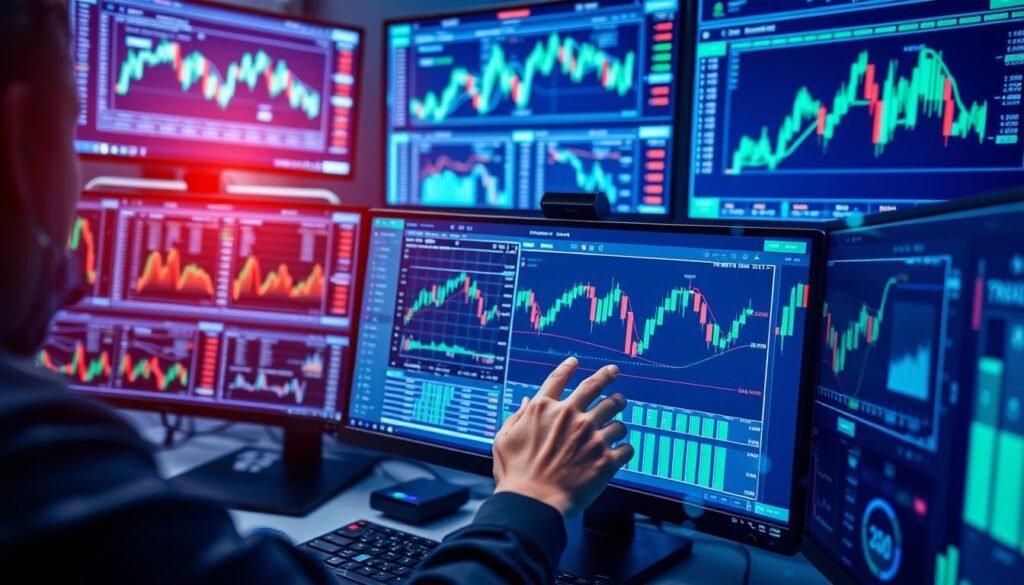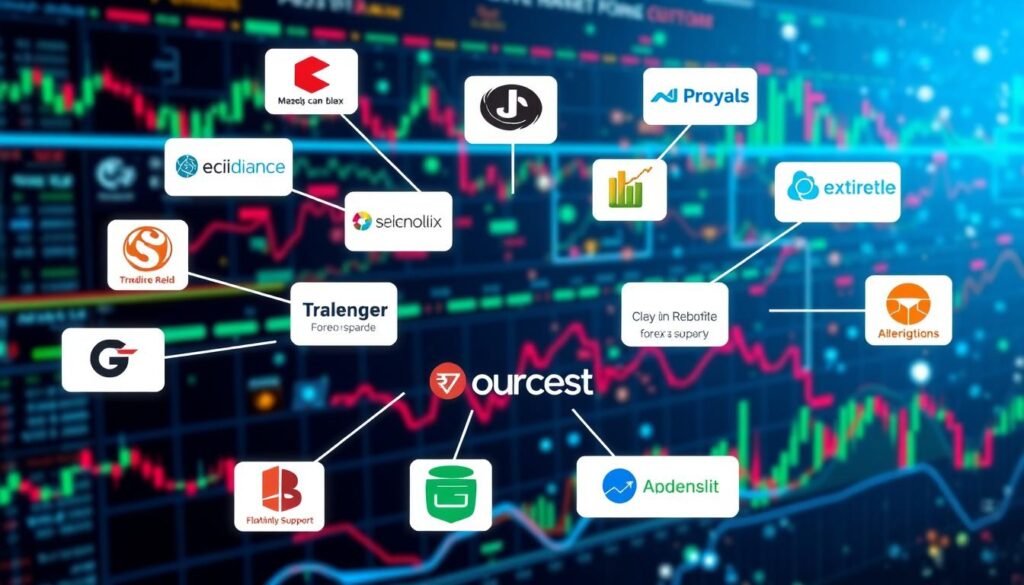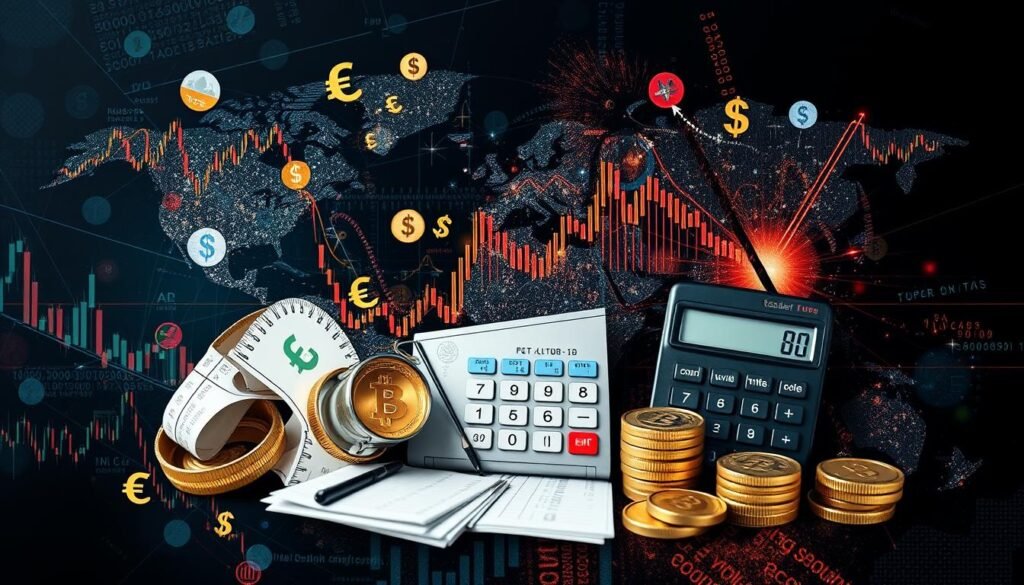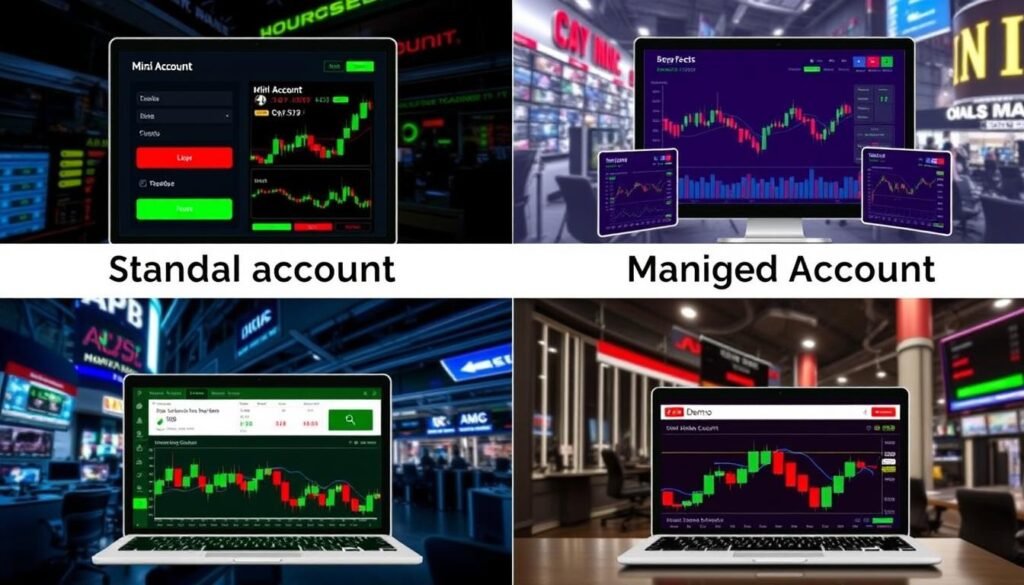Forex Trading in Australia: Your Guide to Success
G’day, mates! Are you ready to dive into the thrilling world of forex trading in Australia? This guide has everything you need to succeed in the dynamic foreign exchange market. We cover the basics and effective trading strategies.
Whether you’re a seasoned trader or just starting, we’ve got you covered. Join us as we explore the ins and outs of forex trading in the land Down Under.
Key Takeaways
- Discover the fundamentals of the forex market and its benefits for Australian traders.
- Learn how to choose a reputable and reliable forex broker in Australia.
- Explore the top forex trading platforms and tools available to Aussie traders.
- Uncover effective trading strategies, including technical and fundamental analysis.
- Understand the importance of risk management and develop a winning mindset.
What is Forex Trading?
Forex trading, also known as the foreign exchange market, is the biggest and most liquid financial market globally. It involves buying and selling different currencies to profit from their exchange rate changes. Traders buy one currency and sell another, hoping to make money from their value differences.
Understanding the Foreign Exchange Market
The forex market is a global market where all currencies trade. It’s open 24/7, 5 days a week, driven by international trade and investment. It’s made up of banks, financial institutions, and individual traders who trade currencies.
Benefits of Forex Trading
- High Liquidity: The forex market is the most liquid, with trillions traded daily. This means trades can be executed quickly and efficiently.
- 24-Hour Trading: The market is open 24/7, 5 days a week. This gives traders the flexibility to trade at any time.
- Leverage: Forex trading offers high leverage. This can increase both profits and losses, allowing for large positions with small investments.
- Accessibility: Forex trading is open to both individuals and institutions. It has low barriers to entry and many trading platforms and brokers available.
The forex market offers many opportunities to profit from currency movements. By understanding the market and its benefits, investors can make informed decisions. This can help them achieve their financial goals.
Getting Started with Forex Trading in Australia
If you’re new to forex trading australia for beginners, picking a good best forex brokers australia is key. This choice can greatly affect your trading success. So, it’s important to research well.
Choosing a Reputable Forex Broker
When how to choose a forex broker australia, consider these important points:
- Regulation and Licensing: Choose a broker with an ASIC license or other top financial authorities. This keeps your money safe and ensures the broker follows strict rules.
- Trading Platforms: Check if the platform is easy to use, fast, and has useful tools and resources.
- Account Types: Look at the different accounts like mini, standard, and VIP. Pick one that fits your trading style and budget.
- Customer Support: Make sure the broker has good customer support. You might need help while trading.
- Fees and Commissions: Compare the broker’s fees, spreads, and commissions. This helps you find the best deal.
By looking at these points, you can pick a best forex brokers australia that meets your needs. This will help you start your forex trading australia for beginners journey on the right foot.
| Broker | Regulation | Platforms | Account Types | Fees |
|---|---|---|---|---|
| XYZ Forex | ASIC | MetaTrader 4, cTrader | Mini, Standard, VIP | Competitive spreads, low commissions |
| ABC Investments | ASIC, FCA | Proprietary, TradingView | Micro, Standard, ECN | Variable spreads, no commissions |
| Stellar Forex | ASIC, CySEC | MetaTrader 5, WebTrader | Cent, Standard, Pro | Low spreads, competitive commissions |
“Choosing the right best forex brokers australia is crucial for your forex trading australia for beginners journey. Spend time researching and comparing to find the best fit for you.”
Forex Trading Platforms
In Australia, picking the right forex trading platform is key. The top forex trading platforms in Australia make trading smooth and easy. They help traders feel confident in the fast-changing foreign exchange market.
Important features of forex trading platforms include real-time market data and advanced charts. These tools let traders keep up with the market and make smart choices.
Australian traders have many forex trading platforms to choose from. There are web-based apps, desktop software, and mobile apps. Each has its own special features, meeting different trader needs and styles.
- Web-based platforms: These cloud-based solutions let traders access their accounts from any device with internet. They’re great for trading on the go.
- Desktop platforms: These are for serious traders. They have more tools, customizable charts, and advanced order features.
- Mobile apps: These apps keep traders connected to the market anytime, anywhere. They offer a simple and effective way to trade on the move.
When picking a forex trading platform in Australia, think about ease of use and speed. Also, consider educational resources and customer support. Comparing options helps traders find the best platform for their style and goals.
“The right trading platform can make all the difference in your forex trading journey. Choosing the best forex trading platforms in Australia is a crucial step towards achieving your financial goals.”
Forex Trading Strategies for Beginners
Starting out in forex trading means learning different strategies to succeed. Two key methods are technical and fundamental analysis. Let’s dive into each.
Technical Analysis Strategies
Technical analysis looks at past price movements to find trading chances. Beginners use tools like moving averages and chart patterns. These help spot trends and decide when to buy or sell.
- Moving Average Crossover: Watching when short-term and long-term averages cross over to find trading signals.
- Relative Strength Index (RSI): Checking the currency pair’s momentum to see if it’s overbought or oversold.
- Fibonacci Retracements: Using Fibonacci ratios to find support and resistance levels for trading.
Fundamental Analysis Strategies
Fundamental analysis looks at big economic factors that affect currency values. Beginners should learn about economic indicators and central bank policies. This helps understand the market’s underlying forces.
- Interest Rate Differential: Noting how interest rate changes affect currency pairs.
- Economic Indicators: Watching key economic data like GDP and inflation to judge an economy’s strength.
- Geopolitical Events: Keeping up with global events and policy changes that impact currency values.
Successful forex trading mixes good strategies, market knowledge, and risk control. Beginners can use both technical and fundamental analysis. This way, they can craft a trading plan that fits their goals and risk level.
| Technical Analysis Strategies | Fundamental Analysis Strategies |
|---|---|
| Moving Average Crossover | Interest Rate Differential |
| Relative Strength Index (RSI) | Economic Indicators |
| Fibonacci Retracements | Geopolitical Events |
“In the world of forex trading, understanding the fundamentals and technical aspects of the market is essential for beginners to thrive.”
Risk Management in Forex Trading
Effective risk management is key to successful forex trading. For traders in Australia, knowing how to manage risks can lead to profits or losses. Two main strategies are using stop-loss orders and proper position sizing.
Stop-Loss Orders
Stop-loss orders help limit losses for forex traders. They close a trade when the price hits a set level, stopping further losses. By setting the right stop-loss levels, traders can manage their forex trading risk management and keep their capital safe.
Position Sizing
Position sizing is another vital risk management tool. It’s about choosing the right trade size based on your account balance, risk tolerance, and trade setup. This way, a single losing trade won’t hurt your whole portfolio too much.
| Risk Management Technique | Description | Benefits |
|---|---|---|
| Stop-Loss Orders | Automatically close a trade when the market price reaches a predetermined level | Limit potential losses, protect capital, manage forex trading risk management |
| Position Sizing | Determine appropriate trade size based on account balance, risk tolerance, and trade setup | Ensure single losing trade does not have disproportionate impact, manage position sizing forex |
By using these risk management strategies, forex traders in Australia can trade with more confidence. They can better protect their capital, leading to long-term success.
Forex Trading in Australia: Regulations and Taxation
If you trade forex in Australia, knowing the rules and taxes is key. The Australian Securities and Investments Commission (ASIC) watches over the market. They make sure traders follow rules to keep everyone safe and the market stable.
Brokers in Australia must have an Australian Financial Services (AFS) license. This license shows they meet high standards. It gives traders peace of mind when picking a trading platform.
Trading forex in Australia also means thinking about taxes. Gains from trading are seen as capital gains for tax. This means traders might have to pay capital gains tax on their profits. It’s wise to talk to a tax expert to follow all tax laws.
| Forex Trading Regulations in Australia | Forex Trading Taxes in Australia |
|---|---|
|
|
Understanding the rules and taxes of forex trading in Australia helps traders. It lets them trade with confidence and follow the law. Being informed and proactive is crucial for success in the fast-paced world of forex trading.

Forex Trading in Australia: Education and Resources
Learning and using good resources are key for forex trading success in Australia. Whether you’re new or have experience, there’s a lot to learn. Educational opportunities and resources can boost your skills and keep you updated.
Online Courses and Webinars
Many online platforms have forex trading courses and webinars for the Australian market. These resources cover topics like analysis, strategies, and managing risks. Some top forex trading education australia choices include:
- The Australian Institute of Financial Education (AIFE) has online courses, like “Forex Trading for Beginners”.
- IG Academy, part of IG, offers free webinars and masterclasses for forex trading resources australia.
- The ASX Sharemarket Game lets traders practice with real-time market experiences.
Books and Blogs
There’s also a lot of educational books and blogs for best forex trading courses australia. They give insights into markets, strategies, and trader psychology. Some essential reads are:
- “Currency Trading for Dummies” by Brian Dolan, a great start for beginners.
- The “FX Empire” blog, covering forex topics with a focus on Australia.
- “The Forex Trading Coach” by Andrew Mitchem, a well-known trader and educator.
“Continuous learning and access to reliable resources are essential for successful forex trading in Australia.”
Forex Trading in Australia: Success Stories
Australia has seen a lot of success in forex trading. Many traders have made it big, showing others what’s possible. They’ve used the foreign exchange market to their advantage, inspiring many.
Sarah Livingston is one such success story. She was a corporate executive until she found forex trading. Her hard work and market insight led to financial freedom and the chance to follow her dreams.
“Forex trading has not only transformed my financial future but has also empowered me to live life on my own terms. It’s a journey that requires discipline, patience, and a deep understanding of the market, but the rewards are truly extraordinary.”
Michael Nguyen is another standout in Australia’s forex scene. He’s a self-taught trader who’s made a name for himself with his unique strategies. Despite many obstacles, he kept going, perfecting his craft and achieving great success.
- Sarah Livingston: From corporate executive to successful forex trader, Sarah’s story exemplifies the transformative power of determination and market expertise.
- Michael Nguyen: A self-made forex trader who has defied the odds and developed a unique trading approach that has brought him consistent success.
- David Sharma: A former IT professional who discovered his true passion in forex trading, David’s journey is a testament to the power of perseverance and adaptability.
These individuals show that success in forex trading is possible with the right mindset and skills. Their stories remind us that hard work, resilience, and a drive for excellence are key to achieving success in the forex market.
Common Mistakes to Avoid in Forex Trading
Forex trading can be rewarding, but it comes with its own set of challenges. Traders in Australia need to watch out for common mistakes that can stop their progress. Knowing these common forex trading mistakes helps traders to avoid forex trading pitfalls and have a more successful trading journey.
- Over-leveraging: Using too much leverage can increase losses and cause big financial problems. Traders should be careful and manage their risks when setting leverage levels.
- Emotional decision-making: Letting emotions like fear, greed, or overconfidence guide trading can lead to costly errors. It’s important to stay disciplined and objective in trading decisions.
- Lack of a coherent trading strategy: Trading without a clear plan can result in unprofitable trades. Traders should spend time creating a solid, tested strategy.
- Inadequate risk management: Not using risk management tools like stop-loss orders can lead to big losses. Good risk management is key to successful forex trading.
- Ignoring market trends and economic indicators: Not paying attention to market trends and economic data can lead to losing trades. It’s crucial to stay informed and adapt to market changes.
By avoiding these common forex trading mistakes, traders in Australia can set themselves up for long-term success in the foreign exchange market.
“The difference between successful and unsuccessful traders often boils down to their ability to manage risk and emotions, not just their trading skills.”
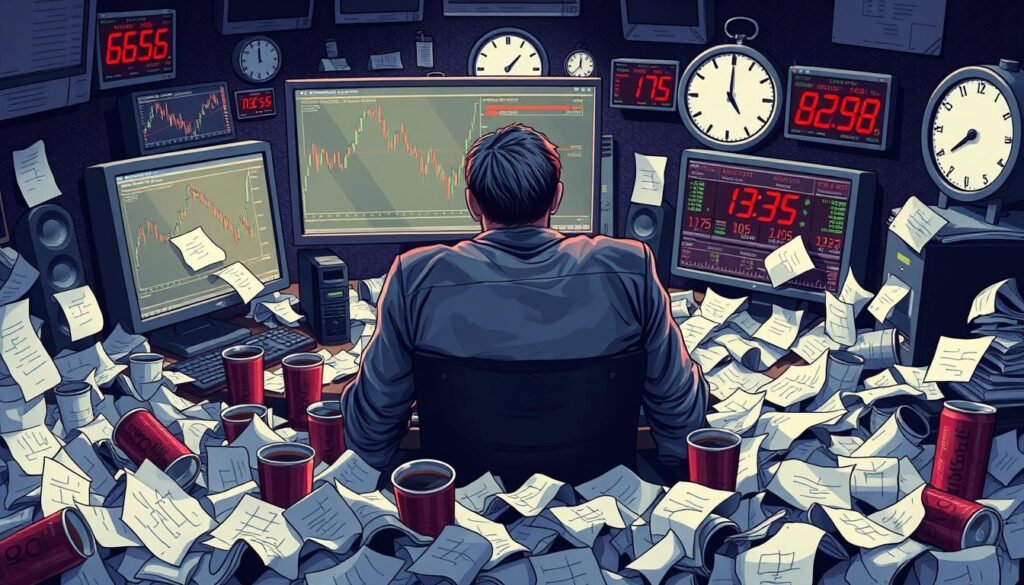
Forex Trading Psychology
Successful forex trading is more than just knowing how to trade. It also needs a deep understanding of trading psychology. We’ll look at how emotional biases affect trading and why a winning mindset is key in the unpredictable forex market.
Overcoming Emotional Biases
Emotions can ruin even the best forex traders. Emotional control is vital in forex trading. Decisions made out of fear, greed, or overconfidence can be very harmful. Traders must know their own emotional traps and find ways to stay objective.
- Recognize and manage fear and anxiety, which can lead to hasty, irrational decisions.
- Avoid the lure of greed, which can tempt traders to hold onto losing positions or take unnecessary risks.
- Cultivate a sense of discipline and patience, resisting the urge to make impulsive trades.
Developing a Winning Mindset
Managing emotions is just part of the battle. Developing a successful forex trading mindset is also essential. Traders need to be mentally strong, adaptable, and always looking to grow to succeed in the forex market.
- Adopt a learning mindset, continuously seeking to expand your knowledge and skills.
- Embrace a resilient mindset, bouncing back from losses and setbacks with determination.
- Maintain a flexible, adaptable mindset, ready to adjust your strategies as market conditions evolve.
By grasping the psychological side of forex trading and working on emotional control and a winning mindset, traders can boost their chances of success in the ever-changing forex market.
Automated Forex Trading Systems
In the fast-paced world of forex trading, automated systems have changed the game. These systems use advanced algorithms to make trades for traders. They aim to make trading easier and more profitable.
Automated trading systems have many benefits. They can trade fast, all day, every day. They also avoid emotional mistakes that humans might make. Plus, they can test strategies, adjust trade sizes, and manage risks well.
Pros of Automated Forex Trading Systems
- Consistent and Disciplined Approach: Automated systems stick to rules, cutting down on emotional mistakes.
- Around-the-Clock Trading: They trade 24/7, catching opportunities that humans might miss.
- Rapid Execution: They can quickly analyze and act on market changes, making the most of short-term chances.
Cons of Automated Forex Trading Systems
- Lack of Adaptability: They might not adjust well to sudden market changes or surprises, leading to poor results.
- Reliance on Data Quality: How well they perform depends a lot on the data they use, which can be wrong or tampered with.
- Potential for Unexpected Losses: They can lose money unexpectedly due to errors, market swings, or other surprises, causing big financial losses.
Thinking about using automated trading systems? It’s key to weigh the good and bad, and what you need and can handle. Getting advice from experts and testing systems before using real money is wise. This way, you can use this new tech wisely and safely.
Forex Trading and Cryptocurrency
The world of finance is changing fast. Now, forex trading and cryptocurrency are more connected than ever. This connection brings both chances and hurdles for those wanting to grow their investments and try new ways to trade.
One big thing about forex trading crypto is how you can use cryptocurrencies in your usual forex trading plans. You can now trade in assets like Bitcoin and Ethereum. This could help you make money from the ups and downs in the crypto world.
But, forex trading with cryptocurrencies also brings new problems. You have to deal with the crypto market’s fast changes, not much regulation, and higher risks. It’s key to manage risks well and really get how forex and crypto work together to do well in this new area.
Even with the tough parts, mixing forex trading crypto can have big pluses. Cryptos can act as a shield against usual money changes. And trading in different types of assets can make your investment mix better and possibly increase your returns.
“The mix of forex and crypto offers both great chances and tricky risks for traders. To succeed, you need to understand the special traits and how each market works.”
The link between forex trading and cryptocurrency will keep being important as the finance world changes. By being smart and informed, you can find new ways to grow and diversify your investments in the fast-changing world of global finance.

Mobile Forex Trading Apps
In today’s world, mobile forex trading apps are key for Australian traders. They offer great convenience and access. This lets traders join the foreign exchange market easily from their phones.
The top forex apps in Australia have lots of features. They help both new and experienced traders. You get real-time data, advanced charts, and easy order management. This helps traders make smart choices and grab market chances anytime.
Many forex trading apps australia are easy to use. They have customizable dashboards and strong risk tools. These mobile forex trading platforms let traders watch their trades, change strategies, and keep up with trends easily.
For both new and seasoned traders, the best forex trading apps australia are great. They give you the tools and info to move through the changing currency markets. With these apps, Australian traders can get into the global financial world. This lets them grab chances and reach their trading goals.
“The rise of mobile trading apps has changed how we trade forex. These apps have made trading easier and more accessible for everyone.”
Top Features of Mobile Forex Trading Apps
- Real-time market data and live price updates
- Intuitive charting tools and technical analysis features
- Seamless order execution and advanced order types
- Comprehensive risk management tools, including stop-loss and take-profit orders
- Customizable notifications and alerts to stay informed of market movements
- Secure access and multi-factor authentication for enhanced account protection
The forex trading world is always changing. The new mobile forex trading platforms have changed how Australian traders work with the markets. These apps offer convenience, function, and easy access. The best forex trading apps australia are now vital for traders wanting to make the most of global currency markets.
Forex Trading in Australia: Future Trends
The Australian forex market is set for an exciting future. New technologies and trading strategies will shape it. Traders in Australia can look forward to these changes.
Artificial intelligence (AI) and machine learning are big in the Australian forex market now. These technologies help traders analyze data and make better trades. AI-powered systems give traders real-time insights, helping them make informed decisions.
There’s also a growing focus on sustainability and ESG factors. Investors want to know their trading impacts on the environment and society. This trend is making trading more ethical and responsible.
| Trend | Description |
|---|---|
| Artificial Intelligence and Machine Learning | AI-driven trading systems and data analysis tools are enhancing decision-making and improving trade execution. |
| Sustainable and Responsible Trading | Increased focus on ESG factors and ethical investing in the Australian forex market. |
| Regulatory Changes | Evolving regulations and policies aimed at enhancing market stability and investor protection. |
| Mobile Trading and Fintech Integration | Seamless mobile trading platforms and the integration of fintech solutions to improve accessibility and user experience. |
Regulatory changes will also shape the future of forex trading australia. Authorities aim to keep the market stable and safe for investors. Expect updates to policies and guidelines to protect investors and promote transparency.
Mobile trading platforms and fintech solutions will become more popular. Traders will have easier-to-use tools for managing their portfolios and making trades anywhere. This trend will help the emerging technologies in australian forex market grow.
As the forex trading scene in Australia changes, staying informed is key. Traders who adapt to these trends will be ready for the future. They’ll have the chance to take advantage of the market’s many opportunities.
Conclusion
As we conclude this guide on forex trading in Australia, it’s clear that this market offers both chances and hurdles. Understanding the basics of the foreign exchange market is key. By using effective strategies and the right tools, Australian traders can aim for success.
Choosing a reliable broker and mastering analysis are crucial. Also, managing risks well and having a positive mindset are important. Keeping up with new rules, taxes, and tech in the industry can also help traders stay ahead.
While the journey to becoming a skilled forex trader has its challenges, this guide provides a strong base. By growing their knowledge, improving their skills, and staying disciplined, Australian traders can confidently tackle the market. They can then reach their financial targets.
FAQ
What is Forex Trading?
Forex trading is the global market where currencies are exchanged. It’s the biggest and most liquid financial market. Traders can speculate on currency pair fluctuations.
What are the Benefits of Forex Trading?
Forex trading offers many benefits. These include high liquidity, 24-hour access, leverage, and profit from both rising and falling markets. It’s also accessible, with low entry barriers and many trading platforms.
How Do I Choose a Reputable Forex Broker in Australia?
Look for a broker licensed by the Australian Securities and Investments Commission (ASIC). Consider the trading platform, account types, educational resources, and customer support.
What are the Best Forex Trading Strategies for Beginners?
Beginners can use technical and fundamental analysis. Technical analysis involves chart patterns and indicators. Fundamental analysis looks at economic factors and market news. A trading plan should match your risk tolerance and goals.
How Can I Manage Risk in Forex Trading?
Managing risk is key in forex trading. Use stop-loss orders and proper position sizing. These strategies help protect your capital in the volatile market.
What are the Regulations and Tax Implications for Forex Trading in Australia?
Forex trading in Australia is regulated by ASIC. Brokers and traders must follow rules. Profits are taxed, so understanding tax implications is crucial.
What Educational Resources are Available for Forex Traders in Australia?
Australian traders have many educational resources. These include online courses, webinars, books, and blogs. They help develop skills, stay updated, and improve strategies.
What are the Common Mistakes to Avoid in Forex Trading?
Avoid over-leveraging, emotional decisions, poor risk management, and bad trade execution. A disciplined approach, risk management, and avoiding pitfalls are key to success.
How Can I Develop a Winning Forex Trading Mindset?
A winning mindset is essential. Overcome emotional biases, be patient and disciplined, and stay positive in volatile markets.
What are the Pros and Cons of Automated Forex Trading Systems?
Automated systems offer fast execution, reduced biases, and strategy optimization. But, they risk system failures and need constant monitoring.






